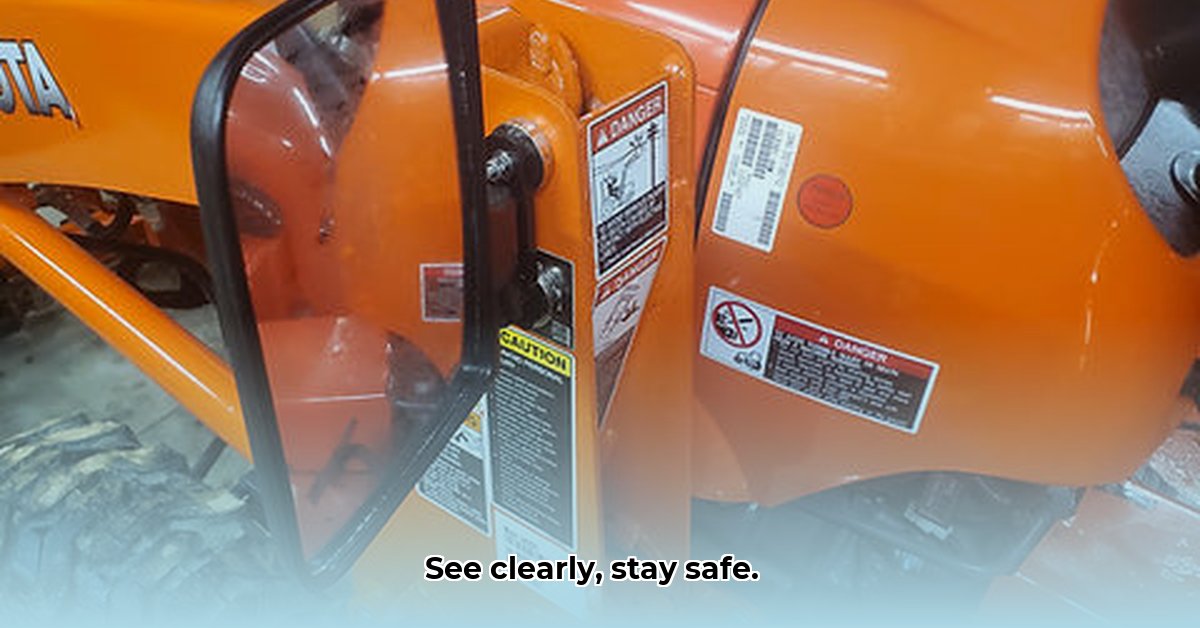
Tractor Mirrors: Your Eyes in the Field
Farming demands intense focus and precision. Operating a tractor, especially with attached implements or heavy loads, presents significant safety risks. Blind spots, caused by inadequate rear-view mirrors, are a leading contributor to tractor accidents. These accidents result in substantial financial losses due to equipment damage, medical expenses, and lost productivity – impacting both the farm's economic viability and the well-being of the operator. This comprehensive guide provides essential information on selecting, installing, and maintaining tractor mirrors to enhance safety and efficiency on your farm. For additional tractor attachment options, check out this link for John Deere tractor attachments.
Why Proper Rear-View Mirrors Matter: More Than Just Seeing
The consequences of inadequate rear-view visibility extend far beyond minor inconveniences. According to a recent study by the National Institute for Occupational Safety and Health (NIOSH), a significant percentage of tractor-related accidents are directly attributable to poor visibility. Have you ever considered the hidden costs associated with a seemingly minor accident? These costs include not just vehicle repair but also potential injury to the operator, lost workdays, delays in harvesting, and the overall economic strain on the farm. Investing in proper mirrors is an investment in your future and the well-being of your team.
Choosing the Right Tractor Mirrors: Finding Your Perfect Fit
Selecting the right mirrors involves careful consideration of several key factors. Understanding the nuances of each type and ensuring a proper fit for your tractor will significantly enhance safety and operational efficiency.
Mirror Type: Convex vs. Flat
- Convex Mirrors: These offer a wider field of view, ideal for detecting objects at a distance; however, objects appear smaller and farther away than they actually are (this is called distortion). This requires a slight adjustment in perception when used.
- Flat Mirrors: Provide a more accurate representation of objects' size and distance, offering a clearer view of what is directly behind the tractor; however, their field of view is more limited than with convex mirrors.
Mirror Size: Balancing Visibility and Maneuverability
While larger mirrors generally offer better visibility, excessively large mirrors can obstruct the driver's view in other areas, creating new blind spots. The optimal size depends on your tractor's size and the typical operating environment. Smaller tractors working in confined spaces will need smaller mirrors compared to larger tractors operating in open fields.
Mounting: Ensuring a Secure and Durable Fit
Secure mounting is paramount. Some tractors have pre-installed mounting brackets, simplifying installation. Others may require drilling and custom fabrication of brackets. Choose a mounting system that firmly attaches the mirrors, capable of withstanding vibrations and impacts during field operation. Consider the following:
- Existing Brackets: Utilize existing mounts whenever possible for ease of installation.
- Drilling: If drilling is necessary, ensure you drill pilot holes to avoid damaging the tractor's chassis. Use appropriate sealant to prevent rust and water damage.
- Magnetic Mounts: These are suitable for temporary installations or quick adjustments, but for permanent solutions a more robust mounting system is advised.
Installation Guide (Step-by-Step): A Practical Approach
This step-by-step guide provides general instructions; consult your mirror's manufacturer's instructions for specific details.
Step 1: Preparation: Gather necessary tools (wrenches, drill, sealant, measuring tape) and carefully clean the mounting area on the tractor.
Step 2: Measurement & Marking: Precisely measure and mark mounting locations. Consider visibility angles and avoid obstructing other functional parts of the tractor.
Step 3: Secure Mounting: Carefully attach the mirror brackets using appropriate fasteners. For drilling, use pilot holes to avoid cracks, and liberally apply sealant where necessary.
Step 4: Mirror Attachment: Securely attach the mirrors to the brackets, ensuring a firm and stable fit.
Step 5: Adjustment & Testing: Adjust the mirrors for optimal visibility. Test in a safe area before actual farm operations.
Maintenance and Safety Tips: Regular Checks for Optimal Performance
Regular inspection and maintenance are vital for ensuring continued safety and optimal visibility.
- Cleaning: Regularly clean mirrors with a suitable cleaner and soft cloth to remove mud, dirt, and debris.
- Inspection: Frequently check for cracks, damage, or loose mounting. Replace damaged mirrors immediately. This should be part of your pre-operational tractor inspection checklist.
Regulatory Compliance and Future Trends: Advocating for Enhanced Safety
While specific regulations concerning tractor mirrors vary by region, there's growing momentum towards stricter safety standards. Farmers should:
- Stay Informed: Keep abreast of any changes in local agricultural safety regulations.
- Advocate for Change: Join agricultural advocacy groups to promote improved safety standards for all farmers.
Mirror Type Comparison: A Quick Summary
| Mirror Type | Pros | Cons |
|---|---|---|
| Convex | Wide field of view | Distorted image, objects appear smaller |
| Flat | Accurate image representation | Narrower field of view |
Remember, selecting the right tractor mirrors is a crucial investment in your safety, productivity, and farm's profitability. Don't compromise on safety. Prioritize your well-being and the well-being of your team by making this essential upgrade a top priority.